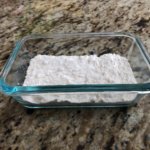Daily STREAM Activity: Moon Craters
Discover how craters are formed!
Activity best for children age 3 and up
Get your rocket ship ready because we are headed to outer space to learn all about the moon! Throughout the month of January we will be exploring the moon through hands-on STREAM activities you can try at home.
Have you ever observed the moon in the night sky? What did it look like? You probably cannot tell looking up from Earth, but the moon is covered in craters! An impact crater is created when a space object, like an asteroid, comet, or meteoroid, hits the surface of a planet or moon. Craters can be many different sizes and shapes, and one of the largest craters found on the moon is called Tycho Crater. Scientists study the moon using telescopes and spacecraft. For example, NASA’s Lunar Reconnaissance Orbiter has been circling our moon and sending back measurements since 2009. This special tool helps scientists observe the moon without having to travel into space themselves. For today’s activity we are going to experiment with some household objects and ingredients to observe the formation of a crater.

Materials you’ll need:
Small container with flat bottom
Flour
Cinnamon or other colored spice
Small objects like marbles, coins, balls of foil, rocks, etc.
Guiding Questions:
While observing the moon, what does it look like? Are there any strange patterns or features you notice? Can you see any craters looking at the moon with only your eyes?
Do you think there are craters on Earth?
What do you think it would be like to travel to the moon?
Directions
STEP 1
Fill your small container with about a ½ inch of flour.

STEP 2
Carefully sprinkle cinnamon or other spice on the surface of the flour. The difference in color will help you notice the features of each crater you form.

STEP 3
Gather a few objects to represent comets, asteroids, or meteoroids.

STEP 4
Drop the objects into your container one at a time. What do you notice? What happens when you drop them from different heights? Does the weight of the object affect the size or shape of the crater? Which object created the largest crater?

Additional Resources
The information and materials used to create this post were generously provided by the NISE Network.
Share your discoveries with us on Instagram by tagging @sdcdm320!
Questions about this activity? Email education@sdcdm.org

